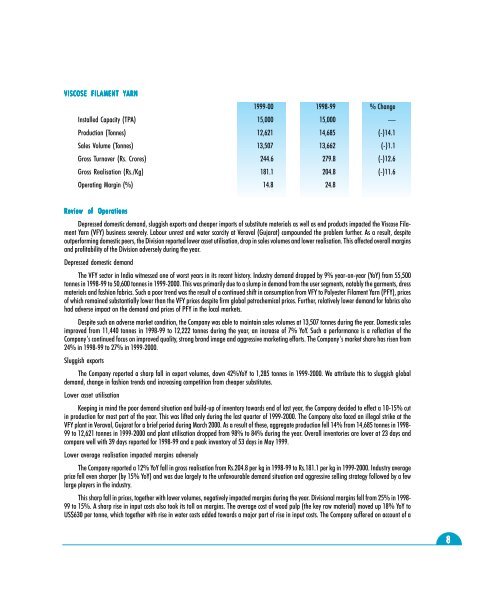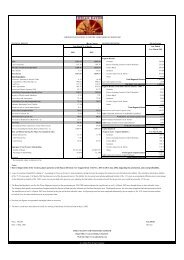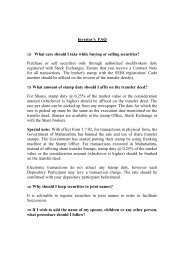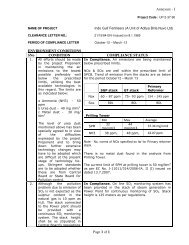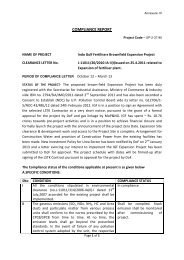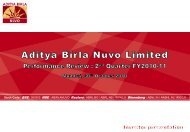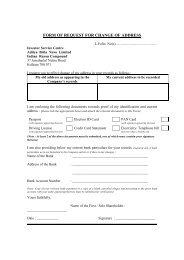INDIAN RAYON AND INDUSTRIES LIMITED - Aditya Birla Nuvo, Ltd
INDIAN RAYON AND INDUSTRIES LIMITED - Aditya Birla Nuvo, Ltd
INDIAN RAYON AND INDUSTRIES LIMITED - Aditya Birla Nuvo, Ltd
You also want an ePaper? Increase the reach of your titles
YUMPU automatically turns print PDFs into web optimized ePapers that Google loves.
VISCOSE FILAMENT YARN<br />
1999-00 1998-99 % Change<br />
Installed Capacity (TPA) 15,000 15,000 —<br />
Production (Tonnes) 12,621 14,685 (-)14.1<br />
Sales Volume (Tonnes) 13,507 13,662 (-)1.1<br />
Gross Turnover (Rs. Crores) 244.6 279.8 (-)12.6<br />
Gross Realisation (Rs./Kg) 181.1 204.8 (-)11.6<br />
Operating Margin (%) 14.8 24.8<br />
Review of Operations<br />
Depressed domestic demand, sluggish exports and cheaper imports of substitute materials as well as end products impacted the Viscose Filament<br />
Yarn (VFY) business severely. Labour unrest and water scarcity at Veraval (Gujarat) compounded the problem further. As a result, despite<br />
outperforming domestic peers, the Division reported lower asset utilisation, drop in sales volumes and lower realisation. This affected overall margins<br />
and profitability of the Division adversely during the year.<br />
Depressed domestic demand<br />
The VFY sector in India witnessed one of worst years in its recent history. Industry demand dropped by 9% year-on-year (YoY) from 55,500<br />
tonnes in 1998-99 to 50,600 tonnes in 1999-2000. This was primarily due to a slump in demand from the user segments, notably the garments, dress<br />
materials and fashion fabrics. Such a poor trend was the result of a continued shift in consumption from VFY to Polyester Filament Yarn (PFY), prices<br />
of which remained substantially lower than the VFY prices despite firm global petrochemical prices. Further, relatively lower demand for fabrics also<br />
had adverse impact on the demand and prices of PFY in the local markets.<br />
Despite such an adverse market condition, the Company was able to maintain sales volumes at 13,507 tonnes during the year. Domestic sales<br />
improved from 11,440 tonnes in 1998-99 to 12,222 tonnes during the year, an increase of 7% YoY. Such a performance is a reflection of the<br />
Company’s continued focus on improved quality, strong brand image and aggressive marketing efforts. The Company’s market share has risen from<br />
24% in 1998-99 to 27% in 1999-2000.<br />
Sluggish exports<br />
The Company reported a sharp fall in export volumes, down 42%YoY to 1,285 tonnes in 1999-2000. We attribute this to sluggish global<br />
demand, change in fashion trends and increasing competition from cheaper substitutes.<br />
Lower asset utilisation<br />
Keeping in mind the poor demand situation and build-up of inventory towards end of last year, the Company decided to effect a 10-15% cut<br />
in production for most part of the year. This was lifted only during the last quarter of 1999-2000. The Company also faced an illegal strike at the<br />
VFY plant in Veraval, Gujarat for a brief period during March 2000. As a result of these, aggregate production fell 14% from 14,685 tonnes in 1998-<br />
99 to 12,621 tonnes in 1999-2000 and plant utilisation dropped from 98% to 84% during the year. Overall inventories are lower at 23 days and<br />
compare well with 39 days reported for 1998-99 and a peak inventory of 53 days in May 1999.<br />
Lower average realisation impacted margins adversely<br />
The Company reported a 12% YoY fall in gross realisation from Rs.204.8 per kg in 1998-99 to Rs.181.1 per kg in 1999-2000. Industry average<br />
price fell even sharper (by 15% YoY) and was due largely to the unfavourable demand situation and aggressive selling strategy followed by a few<br />
large players in the industry.<br />
This sharp fall in prices, together with lower volumes, negatively impacted margins during the year. Divisional margins fell from 25% in 1998-<br />
99 to 15%. A sharp rise in input costs also took its toll on margins. The average cost of wood pulp (the key raw material) moved up 18% YoY to<br />
US$630 per tonne, which together with rise in water costs added towards a major part of rise in input costs. The Company suffered on account of a<br />
8


